Say what you will about Facebook, the company knows how to make an impression. Its headquarters is spectacularly located on the Menlo Park shore of the Dumbarton Bridge, surrounded by salt flats and the San Francisco Bay. The company’s stand-alone, self-made address, One Hacker Way, tells you everything you need to know from the outside about its attempts to subvert a traditional corporate identity. Inside, art is everywhere.
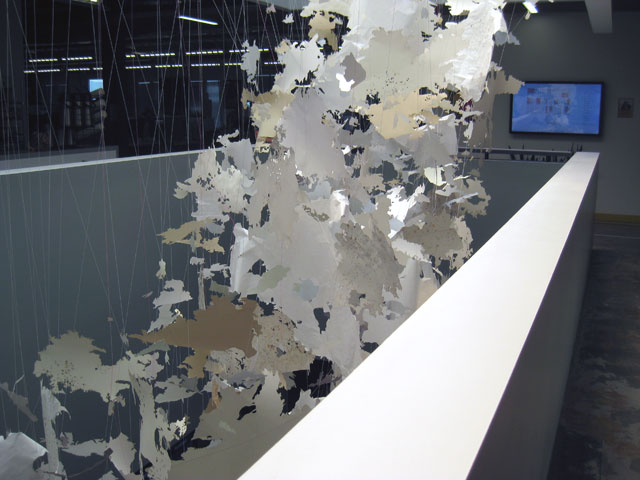
I recently toured Facebook’s Artist-in-Residence (AIR) program with director Drew Bennett to see how artists fit into this new corporate counterculture. As with the online experience, there was much to “like,” much to ignore and still much to consider. The new Frank Gehry-designed offices, called Facebook West, under construction across the street offered a provocative first image.
In one swift decade, Facebook has become so ubiquitous as to defy preamble about its significance in 21st century culture; in all likelihood, you will read this article after seeing it on Facebook. I once saw teenagers ecstatically posing for pictures in front of the parking lot sign — a symbol of rock star success for the digital age. But as well as one might think they know Facebook from the online experience, it is surprising to find that the real life atmosphere is quite different. Whereas the online experience has moments of feeling controlled or regimented, the corporate campus is designed around shared spaces and connectivity. Large-scale site-specific artworks throughout the offices contribute to an atmosphere of polished rebellion.
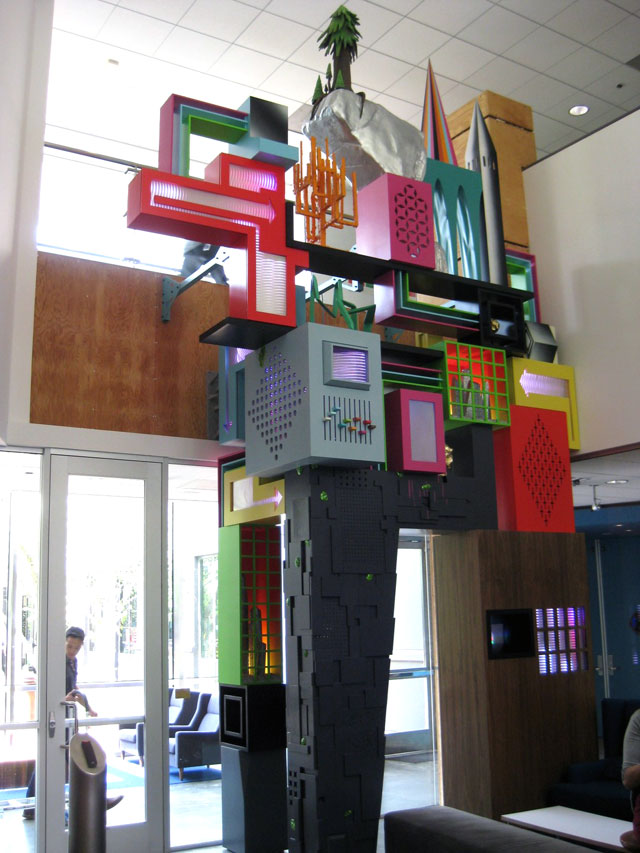
In 2012, artist Drew Bennett was invited by then-Facebook designer Ben Barry to create an official artist-in-residence (AIR) program for the Menlo Park headquarters; they worked together previously when Bennett made work for Facebook. Previously known as Facebook’s Minister of Propaganda, Barry established a guerrilla printmaking studio within the company and published compelling, rebellion-infused broadsheets to post around campus, introducing an whiff of urban energy to Silicon Valley’s serial beigeness. (One of his prints featured the question: “What would you do if you weren’t afraid?”) Barry’s experimental studio eventually became Facebook’s Analog Research Lab, a space for artists and employees to play with different printmaking techniques, simply for the sake of experimentation. A full service wood shop extends these options.

Facebook’s early interest in the street art aesthetic is well documented in the story of muralist David Choe, who accepted payment for office paintings in the form of stock options. A few years later his stock was worth some $200 million after the company went public in 2012; over night Choe became one of the wealthiest artists in the world. Today a Choe diptych presides over the headquarters’ reception area.
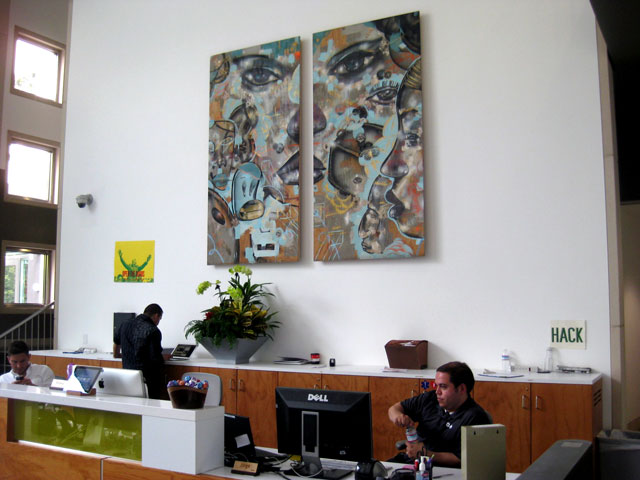
Now in its third season after being launched by Bennett, the official AIR program has invited 28 artists to create site-specific commissions in Menlo Park, with additional artists creating works for the New York office. Many others are considered part of the “pre-official program.”
Today, artists selected for residency are invited to create for a site of their own choosing, in a flexible amount of time, and offered a standard honorarium. (A flat fee of $10K has been bandied about on the Internet, though Bennett declined to confirm a sum.) Artists are also encouraged to experiment with printmaking techniques in the Analog Research Lab and to present a social event for Facebook staff. At the end of the residency, the work belongs to Facebook – in this sense, the Facebook AIR is more a hybrid of site-specific commissions created while in residence, than a conventional residency program.

Bennett says it “is a model of how Facebook manages everyone that works there, with generosity and trust to realize work on their own terms.” It helps that the campus is like a very friendly and beautiful upscale mall with all manner of amenities, including free food and drink everywhere. I compared it to Oz; Bennett says others have likened it to Disneyland.
Former AIR Tucker Nichols said in an email that he went into the experience thinking about “the kinds of questions most workers don’t have time for: What kind of sharing is really going on on Facebook? How do emotions and technology really intersect? Who’s drinking the Kool-Aid? Am I drinking the Kool-Aid? What happens to people who don’t want to drink the Kool-Aid?” He also said that staff seemed really hungry to ask the same questions he had and that “it provided plenty of fodder for making art that reaches into realms beyond my own comprehension.”

Of course the complexities of Facebook are layered and well known. At the same time that it fosters connectivity, and that it is free, it is also focused on different applications for data mining. Former Bay Area artist Christine Wong Yap declined to participate in the program – the only artist to do so to date — and, in a conversation for this article, cited a deep ambivalence about social media’s addictive qualities, with the recent emotional contagion experiment, organized between Facebook and Cornell University, as one example of social media’s inordinate influence. In a post on her blog titled “No, Thank You: Letting a tech-sponsored art opportunity pass,” Wong Yap evenly unpacks her reasons for saying ‘no’ to an opportunity that many others might leap at, chalking much of it up to a commitment to public access and an ingrained distrust of corporate interests.

At present, access to the AIR artwork is limited to employees and, remarkably, the program does not yet even have a Facebook page. One could argue against private corporate art collections as being elitist — in all fairness, they are — but there is also a long historic precedent for this kind of collecting. Access to the Fisher Collection, before it was gifted to SFMOMA, was primarily limited to employees at the Gap Inc. Headquarters. Support for the arts, whether it be public or private, has never been without limitations.
Even as Facebook embraces some brands of rebellion, it is still a vast corporation with complicated politics and privileges. All artists in the program need to be able to work within this paradigm comfortably for the residency to be mutually beneficial, as Bennett is quick to point out.
Artists aren’t offered white cubes: the spaces are functional and transitory, and the lighting — well, it is what it is. The conditions are dictated by the business at hand, but there is something compelling about Facebook’s imperative to create these opportunities for artists to produce new work on site and for staff to see artists at work. In many ways, perhaps because technology is a 24-hour business and employees work erratic hours and consuming schedules, tech campuses emulate village communities and try to provide the same moments of respite and reflection, culture and engagement, that might be found elsewhere in public. It is a mediated experience, but as far as office experiences go, it is a lot better than a sea of cubicles organized in a joyless maze, otherwise known as the ’90s.

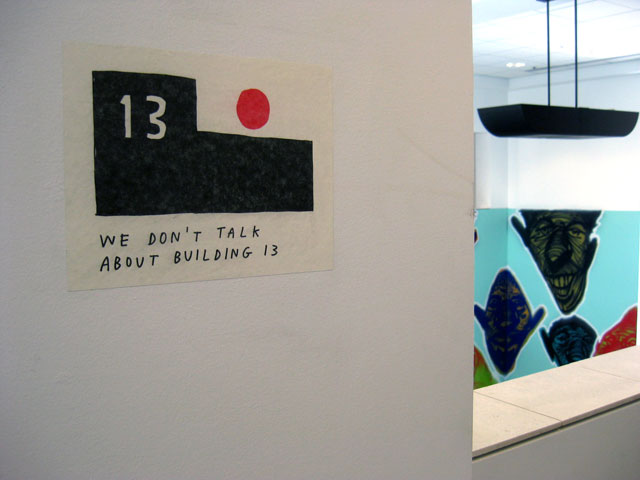
The program is progressive, even as it navigates the parameters of corporate culture, and it seems there is tremendous potential for it to grow into a model for other companies to follow. Bennet says, “The art is not meant to symbolize wealth or suggest prestige. It’s meant to be inspirational and to raise questions about what is possible within this space. The program is designed to be visually disruptive and to challenge people. My hope for this project long term is that we saturate the walls and pour out into public spaces in the surrounding communities.”
Artists are chosen for how well their work embodies a DIY or “hacker ethos,” met with the Bay Area’s hallmark preoccupation with social engagement and models of collaborative production. The vast majority of Menlo Park AIRs have been Bay Area artists — just as those in New York have also been local.
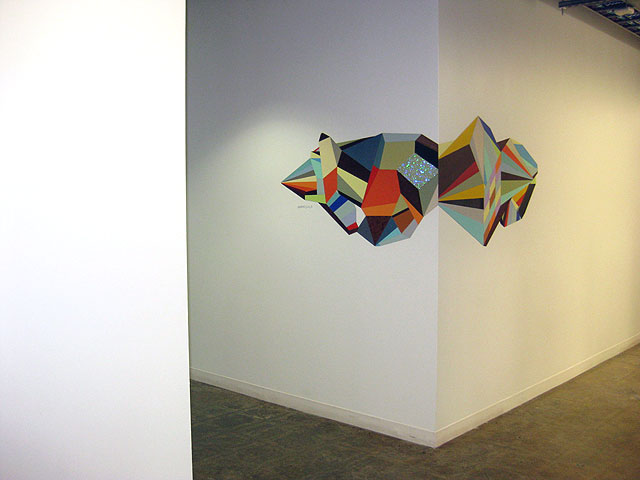
“There is a lot value in taking the time to reach out into the art community to find emerging talent,” says Bennett. “It doesn’t remedy the battle between the tech class and the creative class, but it does create a point of entry to better understand each other.”